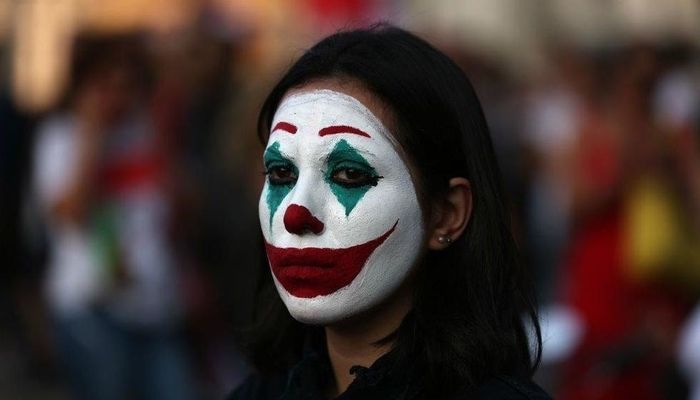
Jean-Luc MOUNIER
Publish: 27 Oct 2019, 04:20 pm

Photo: Collected
Days after the global cinema release of the film 'Joker', the distinctive face of the titular comic-book villain began appearing in political demonstrations all over the world. It's still an underground phenomenon, but does this represent a new form of protest like the wearing of the ‘V for Vendetta’ mask?
From Chile to Lebanon, via Hong Kong and Iraq, a number of people have taken to wearing the recognisable exaggerated smile of the Joker currently portrayed in the cinema by Joaquin Phoenix in the international hit film by Todd Philipps. The face of the Joker, Batman's ultimate nemesis, has now been seen in masks, face paint and graffiti tags in global demonstrations protesting against governments.
“Todd Philipps’ film about the Joker has a real evocative power,” explained William Blanc, historian and author of the book ‘Super Heroes: A Political History’, to FRANCE24. “It echoes a form of protest against a political system that people believe is inflexible and not listening to the people.”
In the weeks since this film came out in the cinema, this Joker symbol of protest has already been visible on the streets, particularly in Lebanon, where a group of graffiti artists called Ashekm has painted a mural of the grimacing clown holding a Molotov cocktail. Other inscriptions elsewhere also allude to Todd Philipps’ film, such as in the Chilean city of Los Angeles, where someone has written at the foot of a statue “We are all clowns”.
Political references to comic strip characters are numerous and the Joker is not the only mask being worn in processions at the moment. In Hong Kong, for example, demonstrators are challenging an emergency law that prohibits the wearing of masks by wearing those of Winnie the Pooh or Pepe the Frog, as noted by the Associated Press.
We are all Guy Fawkes
However, the most commonly used mask globally in protest marches remains the singular face of Guy Fawkes. In the 17th century, Fawkes was the instigator of a failed coup when he attempted to blow up the English Parliament on November 5, 1605. A mask of his face was worn by the character V, an anarchist revolutionary hero in the 2006 cult film ‘V for Vendetta’.
The faceless hacking collective Anonymous (which was established in 2003) adopted Fawkes’ mask as their distinctive signature look and it has since appeared all over the world. This representation has more in common than you might think with the Joker.
“The central theme of these two films is social fragmentation, the fact of finding yourself alone to cope with your own misery,” explains Blanc. “At the end of Todd Philipps’ film, a bit like at the end of ‘V for Vendetta’, everyone putting on the same mask is their way of coming together as a group, to create a collective, to not feel alone with your struggle.”
There is another key link between the two characters: Alan Moore.
‘V for Vendetta’, written by Alan Moore and illustrated by David Lloyd, began in 1982 as a strip in British comic monthly 'Warrior' before gaining a far larger audience when it was compiled as a graphic novel by DC Comics in 1988.
The Joker first appeared in the debut issue of DC's 'Batman' comic in 1940. However, the version of the character that Todd Philipps has directly credited as his inspiration is actually from a 1988 graphic novel, ‘The Killing Joke’, written by the very same Alan Moore.
In ‘V for Vendetta’, “Moore targets fascism and he wrote this at a time of the emergence of a hard and ultraliberal right – Margaret Thatcher in England, Ronald Reagan in the United States. This ideology continues with the Joker,” explains Blanc.
In ‘The Killing Joke’, the character of the Joker takes on a social dimension that is reflected in the film released in 2019. According to the historian, the clown then becomes “a product of a systemic social neglect”.
Deformed by social violence
The parallels between the two characters do not stop there. These masks adopted by today’s protestors display a twisted smile that Blanc describes as “mocking” and “terrifying”.
V and the Joker “are both victims of power and are determined to get their revenge,” he explains. “They share the fact that their bodies have been deformed by social violence. They smile while in so much pain as their way of saying ‘You may have hurt me, but I am strong enough to respond with a smile, I am in control’.
“It’s also a morbid smile. These characters want to terrify powerful people, to make them feel helpless in front of someone for whom exacting revenge is all that matters and they will do whatever it takes to achieve it.”
The question remains, though, as to whether the Joker is intended to embody a political stance. According to Blanc, “the Joker is a plastic character and is not representative of the right or the left”.
He believes that Todd Philipps’ film has inspired demonstrators because “it speaks mainly of being alone, separated from any sense of a collective. This isolation is a real contemporary evil.”
Source: France24.com
Subscribe Shampratik Deshkal Youtube Channel
© 2024 Shampratik Deshkal All Rights Reserved. Design & Developed By Root Soft Bangladesh